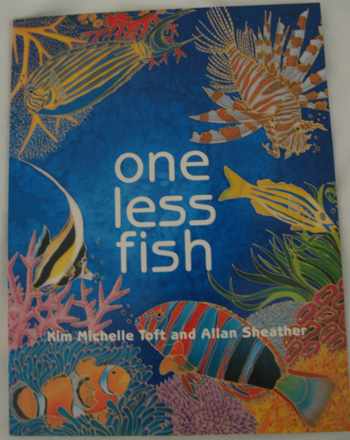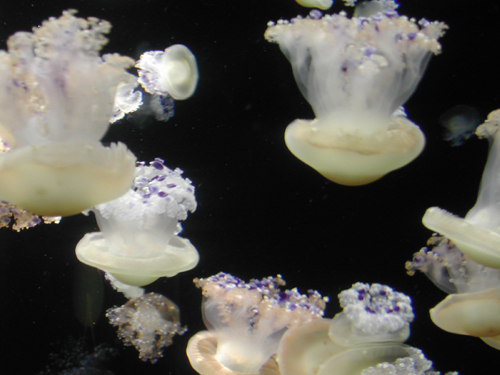Back in February when we visited the Monterey Bay Aquarium, my communing-with-jellies time included an interval gazing at the cross jelly (Mitrocoma cellularia).

Back in February when we visited the Monterey Bay Aquarium, my communing-with-jellies time included an interval gazing at the cross jelly (Mitrocoma cellularia).

During our second day at the Monterey Bay Aquarium last weekend, I finally got my much needed jelly time. I also had occasion to notice that their jelly exhibits have shrunk significantly since their height a few years ago, and that some of my favorite varieties are no longer on display. Booo! MOAR JELLEES PLEEZ!
Ahem. Where was I?
Anyway, there are still some pleasing jellies on display. One of these is the purple-striped jelly (Chrysaora colorata).

We’re back at the Monterey Bay Aquarium today. Shortly after our arrival, the kids are up to their elbow in touch-tank water. Then, the younger Free-Ride offspring gets critical.
“The decorator crabs here aren’t very decorated.”


We went to the Monterey Bay Aquarium yesterday but, owing to the whims of the kids we were with (our own plus some friends), I didn’t get to spend the hours I usually like to spend staring at jellies.
In fact, I was able to park myself in front of a single tank of jellies for maybe 15 minutes.
However, the tank contained sea nettles (Chrysaora fuscescens), jellies which are fairly gorgeous and hypnotic. It didn’t quite make up for the oppressively loud background music piped into too many of the exhibits, but it gave me a brief interval of awe.
The 12th annual Great Backyard Bird Count, sponsored by the Cornell Lab of Ornithology and the National Audubon Society, will be taking place February 13-16, 2009. This is a lovely (and long-running) bit of citizen science that aims to compile a continent-wide snapshot of bird populations during a few days in February before the spring migrations have started.
Participation is easy:

One less fish
by Kim Michelle Toft and Allan Sheather
Watertown, MA: Charlesbridge Publishing
1998
Within the past week, each of the two Free-Ride offspring picked up this book, read it all the way through, and said to me, “You should write about this for the Friday Sprog Blog.”
Instead of replying, “No, you should write about it,” I said, “OK, I’ll try.” Not just because I’m the mature one here, but because this is a really good book.
The elder Free-Ride offspring drew this picture (on two sides of the same piece of paper).
I think I detect some M.C. Escher influence here.

In browsing through my photo library, I stumbled on pictures from my last trip to the Monterey Bay Aquarium of a jellyfish I haven’t blogged yet, the Mediterranean jelly (Cotylorhiza tuberculata). I consulted the Monterey Bay Aquarium Online Field Guide and discovered that it isn’t listed.
That hardly seems fair!
Stories about the honeybee crisis and colony collapse disorder (CCD) keep turning up in the news (at least here in California, where we grow so many big cash crops like almonds that rely on honeybees to pollinate them). But it turns out that getting to the bottom of CCD is made more difficult by the the gaps in biologists’ knowledge about the wild bee populations. (A lot of the bees pollinating food crops are commercially kept rather than wild.)
But, as reported in an article in the September-October 2008 issue of American Scientist [1], the Great Sunflower Project is enlisting the efforts of citizen scientists to fill in some of those gaps.

The elder Free-Ride offspring drew this lovely rat in a thought-bubble. The critter who is dreaming of an encounter with this rat is revealed below.